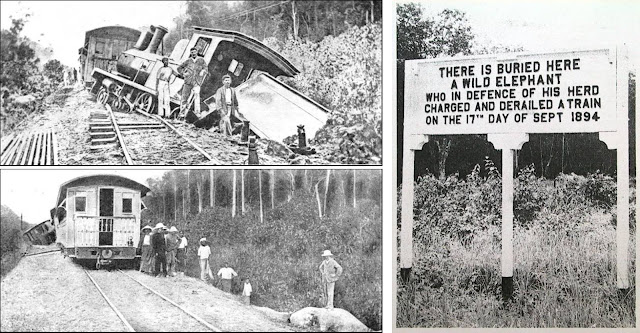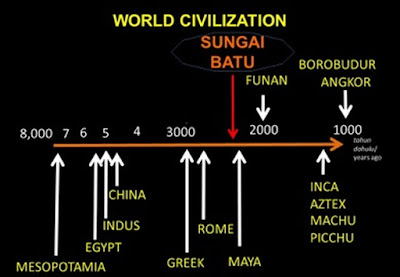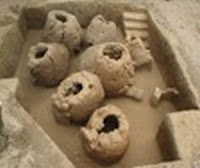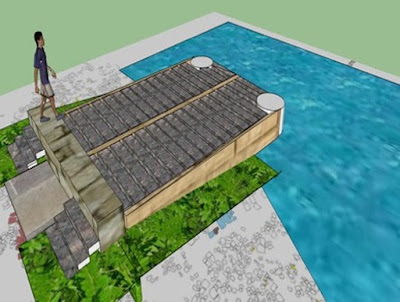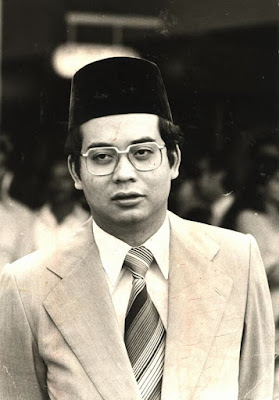Filmmakers interested in producing a TV series on Yap Ah Loy have been urged by one of his descendants to do adequate research so that the true story can be portrayed, writes K.W. MAK.

PROUD DESCENDANT: Tam showing a portrait of Yap Ah Loy from the book The Story of Kuala Lumpur (1857-1939) by J.M. Gullick.
SOME people might call Yap Ah Loy a “gangster”, but to great-granddaughter Irene Tam Mun Choong, he was a national hero who helped build a nation and was a good man.
Tam, who is a direct descendant of Yap Ah Loy’s first son, Hon Chin, said she wants to speak up about her great-grandfather because of the recent interest by filmmakers in making a TV series on him.
“I don’t want all these people to make a film about my great-grandfather without doing research and making a movie that’s more about entertainment than history,” said Tam, a former teacher at La Salle Primary School in Sentul.
“I never knew him personally, but my mother, Yap Nyet Foong, used to tell me all sorts of stories about him.”
Tam said the filmmakers couldn’t get someone like Chow Yuen Fatt to play Yap Ah Loy because he was “a man of medium height”.
“My mother said he possessed a powerful and commanding voice and that he was so strong he could support a sack of rice on the palms of his outstretched hands.
“His hands were supposed to be very long, too, almost to his knees when he stood up.”
Yap Ah Loy married a Malacca Chinese girl and had three sons and a daughter, said Tam. The first son was Hon Chin and the second Loong Chin.
Tam doesn’t know who the third son was but the fourth was a daughter named Kim Neo. There was a fifth child, who was adopted, according to Tam.
“There was a story about my grandfather Hon Chin. When he was born, Yap Ah Loy had his fortune read by mediums and was told that this son would squander his fortune away,” said Tam.
“Great-grandfather was actually contemplating on shooting his own son because of this omen but, luckily for grandfather and myself, the wife got some men to kidnap Hon Chin and hide him in Malacca, where she was from.
“The predictions came true, though. Hon Chin really did squander the fortune away, spending lavishly on women.
“I remember I had many step-grandmothers, one of whom was Japanese and who was very, very kind to me.
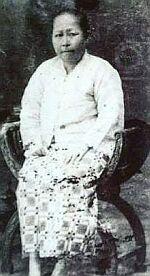
Photograph of Tam's grandmother, Yap Nyet Foong.
“My late mother later told me that my Japanese step-grandmother sent most of the money and gifts that grandfather gave her to Japan so she could have a comfortable life should my grandfather leave her,” said Tam, who guessed that the woman eventually did return to Japan.
To illustrate just how much was squandered, Tam said that at one time, Yap Ah Loy owned 12,000 acres of land along the road between Damansara and Kuala Lumpur.
“A fraction of this was used to plant tapioca and he (Yap Ah Loy) engaged an English engineer to run his tapioca flour factory.”
Continuing the story of Hon Chin, Tam said he had two children, a son, Yap Swee Lin, and Yap Nyet Foong, Tam’s mother. She said Swee Lin had three wives.
“This is the lesson that all men should learn – stay monogamous! I know that I can still claim to be a direct descendant of Yap Ah Loy because my mother was the daughter and not the son who took many wives and concubines.”
Tam, whose real name is Hue Kim Yen (her father's name was Hue Fon Lim), said she took her husband’s name after a frustrating encounter with bank staff who refused to honour cheques cashed to “Mrs Tam Mun Choong”.
“The name has been in my IC ever since,” said Tam.
Tam recalled that one of the only heirlooms to remain with the family was a giant portrait of Yap Ah Loy. But with the extended family being so large, she said, she has lost track of many of her relatives and who had the portrait now or if it still existed.
“I recall a time when I saw two boys fighting by the roadside only to have the parents show up and reveal that the two were cousins,” said Tam, to illustrate just how far apart the extended family had grown.
On the “gangster” label that some quarters tagged him with, Tam said such people should refer to the Oxford Dictionary before they slapped it on a great man like Yap Ah Loy.
“He helped build a jail and imposed punishment on criminals. This denotes that he was a law-abiding person.”
Tam said Yap Ah Loy, who was the founder of Kuala Lumpur, hardly had anything left to help future generations remember the great man he was except for a short road named after him, and the Sin Sze Sin Ya temple in Jalan Tun H.S. Lee, which houses a statue of him.
“I hope the film will eventually give him the recognition he rightly deserves,” she said.
(Star Online, Sunday, 6 Jun 2004)

PROUD DESCENDANT: Tam showing a portrait of Yap Ah Loy from the book The Story of Kuala Lumpur (1857-1939) by J.M. Gullick.
SOME people might call Yap Ah Loy a “gangster”, but to great-granddaughter Irene Tam Mun Choong, he was a national hero who helped build a nation and was a good man.
Tam, who is a direct descendant of Yap Ah Loy’s first son, Hon Chin, said she wants to speak up about her great-grandfather because of the recent interest by filmmakers in making a TV series on him.
“I don’t want all these people to make a film about my great-grandfather without doing research and making a movie that’s more about entertainment than history,” said Tam, a former teacher at La Salle Primary School in Sentul.
“I never knew him personally, but my mother, Yap Nyet Foong, used to tell me all sorts of stories about him.”
Tam said the filmmakers couldn’t get someone like Chow Yuen Fatt to play Yap Ah Loy because he was “a man of medium height”.
“My mother said he possessed a powerful and commanding voice and that he was so strong he could support a sack of rice on the palms of his outstretched hands.
“His hands were supposed to be very long, too, almost to his knees when he stood up.”
Yap Ah Loy married a Malacca Chinese girl and had three sons and a daughter, said Tam. The first son was Hon Chin and the second Loong Chin.
Tam doesn’t know who the third son was but the fourth was a daughter named Kim Neo. There was a fifth child, who was adopted, according to Tam.
“There was a story about my grandfather Hon Chin. When he was born, Yap Ah Loy had his fortune read by mediums and was told that this son would squander his fortune away,” said Tam.
“Great-grandfather was actually contemplating on shooting his own son because of this omen but, luckily for grandfather and myself, the wife got some men to kidnap Hon Chin and hide him in Malacca, where she was from.
“The predictions came true, though. Hon Chin really did squander the fortune away, spending lavishly on women.
“I remember I had many step-grandmothers, one of whom was Japanese and who was very, very kind to me.

Photograph of Tam's grandmother, Yap Nyet Foong.
“My late mother later told me that my Japanese step-grandmother sent most of the money and gifts that grandfather gave her to Japan so she could have a comfortable life should my grandfather leave her,” said Tam, who guessed that the woman eventually did return to Japan.
To illustrate just how much was squandered, Tam said that at one time, Yap Ah Loy owned 12,000 acres of land along the road between Damansara and Kuala Lumpur.
“A fraction of this was used to plant tapioca and he (Yap Ah Loy) engaged an English engineer to run his tapioca flour factory.”
Continuing the story of Hon Chin, Tam said he had two children, a son, Yap Swee Lin, and Yap Nyet Foong, Tam’s mother. She said Swee Lin had three wives.
“This is the lesson that all men should learn – stay monogamous! I know that I can still claim to be a direct descendant of Yap Ah Loy because my mother was the daughter and not the son who took many wives and concubines.”
Tam, whose real name is Hue Kim Yen (her father's name was Hue Fon Lim), said she took her husband’s name after a frustrating encounter with bank staff who refused to honour cheques cashed to “Mrs Tam Mun Choong”.
“The name has been in my IC ever since,” said Tam.
Tam recalled that one of the only heirlooms to remain with the family was a giant portrait of Yap Ah Loy. But with the extended family being so large, she said, she has lost track of many of her relatives and who had the portrait now or if it still existed.
“I recall a time when I saw two boys fighting by the roadside only to have the parents show up and reveal that the two were cousins,” said Tam, to illustrate just how far apart the extended family had grown.
On the “gangster” label that some quarters tagged him with, Tam said such people should refer to the Oxford Dictionary before they slapped it on a great man like Yap Ah Loy.
“He helped build a jail and imposed punishment on criminals. This denotes that he was a law-abiding person.”
Tam said Yap Ah Loy, who was the founder of Kuala Lumpur, hardly had anything left to help future generations remember the great man he was except for a short road named after him, and the Sin Sze Sin Ya temple in Jalan Tun H.S. Lee, which houses a statue of him.
“I hope the film will eventually give him the recognition he rightly deserves,” she said.
(Star Online, Sunday, 6 Jun 2004)
